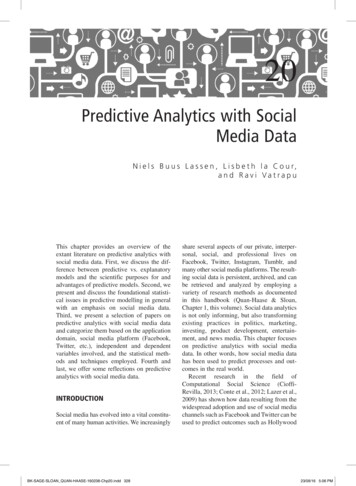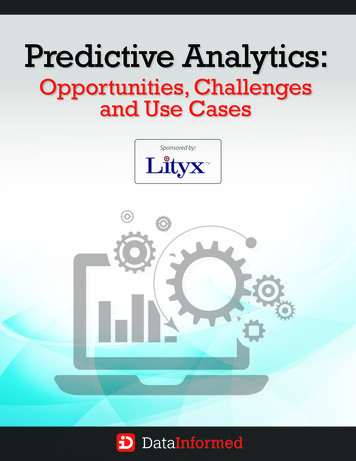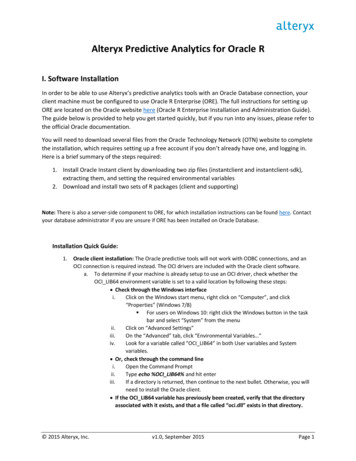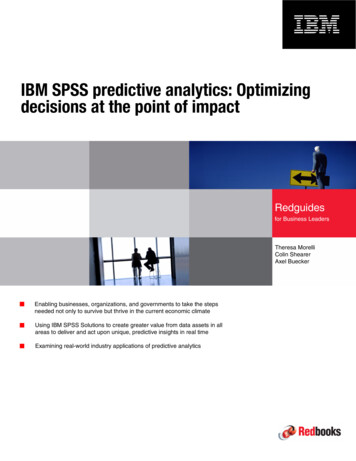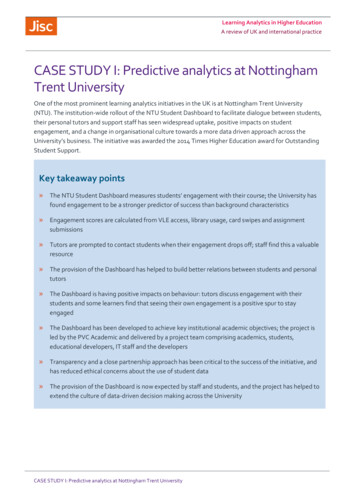
Transcription
Learning Analytics in Higher EducationA review of UK and international practiceCASE STUDY I: Predictive analytics at NottinghamTrent UniversityOne of the most prominent learning analytics initiatives in the UK is at Nottingham Trent University(NTU). The institution-wide rollout of the NTU Student Dashboard to facilitate dialogue between students,their personal tutors and support staff has seen widespread uptake, positive impacts on studentengagement, and a change in organisational culture towards a more data driven approach across theUniversity’s business. The initiative was awarded the 2014 Times Higher Education award for OutstandingStudent Support.Key takeaway points»The NTU Student Dashboard measures students’ engagement with their course; the University hasfound engagement to be a stronger predictor of success than background characteristics»Engagement scores are calculated from VLE access, library usage, card swipes and assignmentsubmissions»Tutors are prompted to contact students when their engagement drops off; staff find this a valuableresource»The provision of the Dashboard has helped to build better relations between students and personaltutors»The Dashboard is having positive impacts on behaviour: tutors discuss engagement with theirstudents and some learners find that seeing their own engagement is a positive spur to stayengaged»The Dashboard has been developed to achieve key institutional academic objectives; the project isled by the PVC Academic and delivered by a project team comprising academics, students,educational developers, IT staff and the developers»Transparency and a close partnership approach has been critical to the success of the initiative, andhas reduced ethical concerns about the use of student data»The provision of the Dashboard is now expected by staff and students, and the project has helped toextend the culture of data-driven decision making across the UniversityCASE STUDY I: Predictive analytics at Nottingham Trent University
Learning Analytics in Higher EducationA review of UK and international practiceRationaleFor NTU, the key strategic driver is enhancing the academic experience for its 28,000 students, particularlytheir engagement with their course. Three more detailed goals were developed from this initial aim:»to enhance retention1»to increase a sense of belonging within the course community, particularly with tutors»to improve attainmentEarlier institutional research by Ed Foster, Student Engagement Manager at NTU, had identified that, inline with other studies, up to a third of students had considered withdrawing at some point during theirfirst year. These ‘doubters’ were less confident about coping with their studies, less engaged with theircourse, formed weaker relationships with peers and tutors, and were ultimately more likely to withdrawearly. This apparent detachment from teaching staff meant that tutors were at risk of putting effort intoassisting those who requested support, rather than those who most needed it.Focussing on overall student engagement rather than the risk of withdrawal has shaped the Dashboard’sdesign and development in four ways:1.2.Students2 and staff see precisely the same informationi.background informationii.most recent engagement with the data sources (for example VLE use)iii.engagement compared to their peers on the same courseThis means that while staff can use the data to initiate conversations with students, the students canbe their own agents of change. Seeing that their engagement is lower than their peers may promptthem to improve it.Because a key goal is to build relationships between tutors and students, the Dashboard sends anemail alert to tutors when student engagement stops for two weeks. These alerts encourage staff tomake early contact with students who are disengaging from their studies rather than waiting for moretraditional warning signs such as assessment deadlines not being met.3.The Dashboard was designed to be used by tutors as they work directly with students; they can makenotes about agreed actions in the Dashboard.4.NTU specifically chose not to make use of demographic data in the analytics model, choosing only touse data relating to student engagement with their course.1 However, retention is not a particular problem at NTU, with around 93% of students progressing from the first to thesecond year.2 Importantly, students only see information about themselves, not their fellow students.CASE STUDY I: Predictive analytics at Nottingham Trent University
Learning Analytics in Higher EducationA review of UK and international practiceFigure 1: Student Dashboard, staff log in viewThe initial projectNTU already had a strong track record of evidence-based quality management, good strategic informationfor senior managers and, importantly, held a significant amount of relevant data in a mature Cognos datawarehouse implementation. However, data was primarily used for operational and quality managementpurposes, not student/ staff interactions. In 2013 the University initiated a pilot to test the feasibility ofusing learning analytics. A project group was sponsored by the PVC Academic3 with representatives fromacademic departments, Information Systems, the Centre for Academic Development & Quality, and theStudents’ Union. Members included experts in data analysis, diversity and student support.A procurement process was initiated, and each interested vendor was offered the opportunity to crunchfive years of anonymised data from seven data sources to see what insight could be obtained.3 Professor Chris Pole led the pilot phase, his successor, Professor Eunice Simmons, the full institutional implementation.CASE STUDY I: Predictive analytics at Nottingham Trent University
Learning Analytics in Higher EducationA review of UK and international practiceSolutionpath was selected as it was the most successful at sorting out and gaining insight from some verycomplex data. This proved to be an effective partnership, the technical work was carried out mainly bySolutionpath; the University coordinated that work, and various IT, academic and research staff weredeployed as required.The Dashboard was initially tested with four courses, forty tutors and over 500 first year students. Therewere some concerns from within the institution about student privacy, potential duplication with existingsystems and value for money, however by the first pilot evaluation point (Christmas 2013), positivefeedback from both students and staff largely allayed these anxieties. The pilot provided usefulinformation about integrating systems, student and staff expectations and ways to incorporate theDashboard into normal working practices.The pilot successfully demonstrated the value of learning analytics, and the Dashboard was implementedthroughout the whole University in September 2014. It was launched using a range of communicationactivities including roadshow presentations in all academic schools. For the most part these briefings wereused to introduce learning analytics, discuss the ethical and process implications and explore goodpractice. The tool itself is straightforward to use, requiring only limited training. The impact on academictime required to make use of it was minimal; this was important for its adoption.Figure 2: A student profile as viewed by their tutorCASE STUDY I: Predictive analytics at Nottingham Trent University
Learning Analytics in Higher EducationA review of UK and international practiceData sources and indicators of engagementData comes from a number of sources and is collected in an NTU data warehouse. Biographical data suchas the student’s enrolment status is drawn from the student information system4. Actual engagement datacomes from four separate systems: the virtual learning environment (VLE), the card access database, theassessment submission system and the library system. The indicators used in the analytics are calculatedfrom door swipes into academic buildings, visits to the VLE, the submission of assignments and a count ofwhen library resources were taken from the library. These were selected from a range of variables usingthe Solutionpath algorithm that identified them as the most significant indicators of student engagement.Each student receives one of five engagement ratings: High, Good, Partial, Low and Not Fully Enrolled.The analytics model at the core of the system is the intellectual property of Solutionpath. NTU does notknow the core algorithms driving the resource. However, as part of the procurement process, thedevelopers demonstrated the accuracy of the tool to the University, by correctly predicting students mostat risk of early departure at two census points. Furthermore, in the 2013-14 pilot year the project teamanalysed the relationship between engagement as measured in the Dashboard and academic attainment(see Findings and Outcomes below).The team chose not to include student demographics in the predictive algorithms. In early discussions thedevelopers found some evidence to show an impact based on who students were. However, as Ed says,“The Dashboard is about student engagement. We didn’t want to be in a situation where two studentsmight be engaging in precisely the same way with their studies but we gave one a lower score becausethey were male, or came from a poorer socio-economic background. Students can’t do anything abouttheir background characteristics, but they can do something about the way that they engage with theircourse. Remember students can see their own Dashboard and we want this to be a tool that motivatesthem.”Dashboards and interventionsThe Dashboard was developed both for students to sense check their engagement against their peers andfor tutors to discuss the students’ performance with them. Two visualisation charts show a progress lineindicating engagement, comparing individual students with the rest of the cohort, and showing thestudent’s engagement rating. The tutor can drill down to the level below the rating to gain a betterunderstanding of the student’s recent engagement with the course.4 This information is not used in the analytics algorithm, but is used to provide staff with contextual information and toconduct cohort-level analysis.CASE STUDY I: Predictive analytics at Nottingham Trent University
Learning Analytics in Higher EducationA review of UK and international practiceFigure 3: A student’s cumulative engagement rating compared with the course mean. This view provides students with agood overall view of their engagement for the year, however is less immediately responsive.Automated email alerts are sent to tutors when students have had no engagement for a fortnight. TheUniversity made the decision to send these to the students’ tutors, not directly to the students themselves.This was done specifically to increase opportunities for dialogue between tutors and students, and to helpbuild students’ sense of belonging to the course community. Carefully worded, these emails inform thetutors that they may already know the learners’ circumstances but ask them to consider contacting them.Ed says “We’re trying to initiate conversations rather than replace them.” Mike Day, Director of IS adds“However, we are interested in finding ways that we can use the technology to improve the dialogue. Forexample, we might develop the system to generate more personalised emails to tutors, for example,where engagement drops from good to partial, where students don’t use the library by a particular cut offdate, or for students with a history of late submission. Although it would be necessary to avoid“spamming” tutors with too many alerts”CASE STUDY I: Predictive analytics at Nottingham Trent University
Learning Analytics in Higher EducationA review of UK and international practiceFigure 4: Week by week engagement score (for the same student as in Figure 3) compared with the course mean. This gives amore responsive view and students can see dramatic changes to their engagement within a weekEthics, legal issues and presentationOverall staff and students can see that there are benefits from the use of learning analytics. There are, ofcourse, some concerns that there is the potential to misuse the data; these appear to be expressed morefrequently by staff than students. At each stage of the Dashboard’s development the project team madegreat efforts to communicate with both students and staff. The ideas were tested with students includingthe Students’ Union elected officers and the student representatives of the Information Services StudentCommittee. On the legal side NTU is using the same core systems as it was previously, so existingcomputing use policies and student enrolment conditions already provide a sufficiently robust legalframework to cover the Dashboard’s operation. However in September 2015, the University implementeda policy for the ‘Use of learning analytics to support student success’5. The Director of AcademicDevelopment, Jane McNeil, stressed that “It was important that the University articulate the academiccontext for learning analytics and acknowledge the limitations of such data.”How the Dashboard is portrayed to students and staff was thought through carefully by the project team.Staff involved in the project have deliberately used positive and inclusive language, and have talked about‘attainment’ rather than ‘retention’ and about ‘success for all’ instead of ‘narrowing the gap’.5 This policy can be found in the NTU Quality Handbook Section 14, Learning and Teachinghttp://ntu.ac.uk/adq/document uploads/quality handbook/150956.pdfCASE STUDY I: Predictive analytics at Nottingham Trent University
Learning Analytics in Higher EducationA review of UK and international practiceFigure 5: Student dashboard showing their engagement over the previous five days along with an explanation of what theengagement ratings mean.Findings and outcomesThe NTU project team has found two key operat
Learning Analytics in Higher Education A review of UK and international practice CASE STUDY I: Predictive analytics at Nottingham Trent University Solutionpath was selected as it was the most successful at sorting out and gaining insight from some very complex data. This proved to be an effective partnership, the technical work was carried out mainly byFile Size: 836KBPage Count: 14
